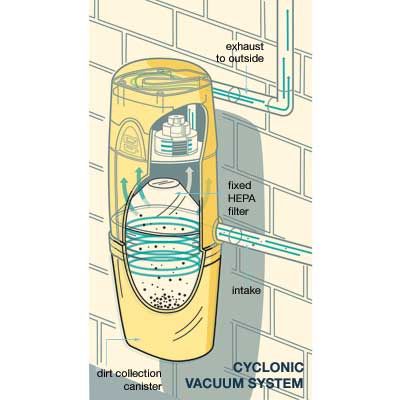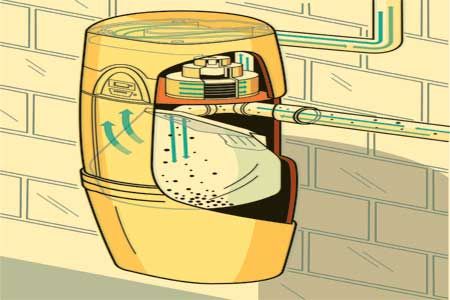Central vacuum systems make home cleaning easier, offering a powerful and convenient alternative to traditional portable vacuums. These built-in systems offer great suction power, improved air quality, and effortless operation. In this guide, we’ll explore how central vacuums work, their benefits, costs, and everything you need to know to decide if a central vacuum system is right for your home.
What Is a Central Vacuum System?
A central vacuum system is a whole-house cleaning solution that removes the need for portable vacuum cleaners. It has a powerful motor unit that’s typically installed in a remote area of the home, such as the basement or garage. The motor connects to a network of pipes running through the walls. Inlet valves are strategically placed throughout the house, allowing you to plug in a lightweight hose and begin cleaning without lugging around a heavy vacuum cleaner.

Benefits of Central Vacuum Systems
Central vacuum systems have several advantages over traditional portable vacuums, making them an increasingly popular choice for homeowners.
Improved Cleaning Power
One of the most significant benefits of a central vacuum system is its superior cleaning power. Because the motor unit doesn’t need to be portable, it can be much larger and more powerful than those in traditional vacuums. This results in significantly stronger suction that can be several times greater than an average upright vacuum. The increased power allows for more thorough cleaning of carpets, hardwood floors, and other surfaces.
Enhanced Indoor Air Quality
Central vacuum systems contribute to better indoor air quality by completely removing dust, allergens, and other particles from your living space. Unlike portable vacuums that can recirculate some dust back into the room, central vacs transport all debris through the in-wall piping to the collection unit. This process helps reduce allergens and improves overall air quality in your home.
“They’re much healthier than the non-HEPA vacuums in most people’s closets,” says Kevin Kennedy, program director of the Environmental Health Program at Children’s Mercy Kansas City.
Convenience and Ease of Use
Using a central vacuum system is remarkably convenient. There’s no need to carry a heavy vacuum up and down stairs or from room to room. You simply plug the lightweight hose into the nearest inlet and start cleaning. The system is also quieter than portable vacuums since the motor unit is located away from living areas, allowing you to clean without disturbing others or interfering with daily activities.
How Central Vacuum Systems Work
Understanding the components and operation of a central vacuum system can help you appreciate its efficiency and effectiveness.
A typical central vacuum system consists of several key components:
- Power unit: The heart of the system, containing the motor and collection canister or bag
- PVC piping: A network of pipes running through walls and floors
- Inlet valves: Wall- or floor-mounted ports where you connect the cleaning hose
- Hose and attachments: Used for actual cleaning, similar to those of portable vacuums
When you plug the hose into an inlet valve, it signals the power unit to turn on. As you clean, debris is sucked through the hose and into the piping system. The powerful airflow carries the dirt and dust to the collection unit, where it’s filtered out of the airstream and deposited into a bag or canister.
Types of Central Vacuum Systems
There are two main types of central vacuum systems, each with its own method of dirt collection.
Cyclonic Systems
Cyclonic systems use centrifugal force to separate debris from the air. As the air spins inside the canister, heavier particles fall into a collection chamber while a filter catches finer particles. These systems don’t require bags, but you’ll need to empty the canister and clean the filter periodically.

Bagged Systems
Bagged systems collect dirt in a disposable bag, similar to traditional vacuum cleaners. These bags typically provide HEPA-quality filtration and need to be replaced about every six months. While you’ll have ongoing costs for replacement bags, the disposal process is generally cleaner and less messy than emptying a canister.
Costs and Installation of Central Vacuum Systems
The cost of a central vacuum system can vary depending on the size of your home and the complexity of the installation.
Average Cost of Central Vacuum Systems
For a newly built 2,200-square-foot house, you can expect to pay between $1,098 and $2,195* for a central vacuum system, including installation. Retrofitting an existing home typically adds to this total cost.
Installation in New Homes
Installing a central vacuum system during new home construction is the most straightforward and cost-effective option. The pipes can be easily run through open walls before drywall is installed, and the power unit can be placed in an optimal location.
Retrofitting Existing Homes
While more challenging, it’s entirely possible to install a central vacuum system in an existing home. Installers can usually run pipes through basements, attics, and inside walls with minimal disruption to your living space. The process may require some patching and repainting, but the end result is worth the minor inconvenience for many homeowners.
*Cost data in this article sourced from contractor estimates used by Angi.
Maintenance and Upkeep
Central vacuum systems require minimal maintenance to keep them running efficiently.
Emptying and Cleaning
For cyclonic systems, you’ll need to empty the collection canister about two to three times a year and clean the filter as needed. Bagged systems require changing the bag when it’s full, typically every six months for average use.
Filter Replacement
You should replace HEPA filters in central vacuum systems according to the manufacturer’s recommendations. Regular filter maintenance ensures optimal performance and air quality.
Common Concerns and Solutions
Addressing common concerns can help you make an informed decision about installing a central vacuum system.
Noise Levels
While central vacuum motors are powerful, they’re typically much quieter in operation than portable vacuums because the power unit is located away from living areas.
Venting Requirements
Some central vacuum systems can be vented outdoors, which can further improve indoor air quality. However, many modern systems are designed to work effectively without external venting.
Power Consumption
Central vacuum systems are generally energy-efficient, using power only when in operation. Many models have low standby power consumption when not in use.
Comparing Central Vacuums To Portable Vacuums
When deciding between a central vacuum system and traditional portable vacuums, consider both cleaning efficiency and long-term costs.
Cleaning Efficiency
Central vacuum systems typically offer superior cleaning power and more thorough removal of allergens and dust from your home. They’re particularly great for whole-house cleaning and maintaining consistent air quality throughout your living spaces.
Long-Term Cost Analysis
While the initial investment for a central vacuum system is higher than that of a portable vacuum, the long-term benefits can outweigh the costs. Central systems have a longer lifespan, require less frequent replacement, and can add value to your home.
Our Conclusion
Central vacuum systems offer a powerful, convenient, and efficient way to keep your home clean while improving indoor air quality. While the initial investment is higher than traditional vacuums, the long-term benefits in terms of cleaning power, convenience, and potential home value increase make them an attractive option for many homeowners.

